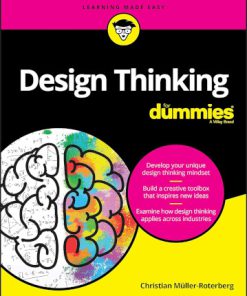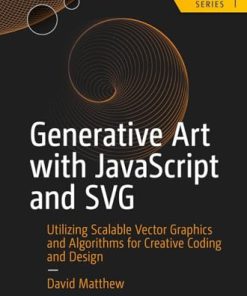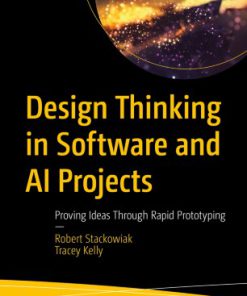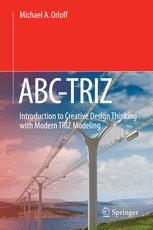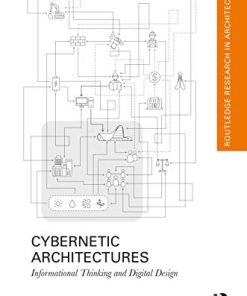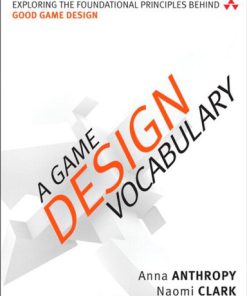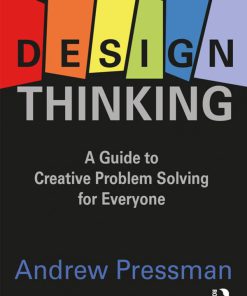Design Thinking Research Making Design Thinking Foundational 1st Edition by Hasso Plattner, Christoph Meinel, Larry Leifer ISBN 3319196405 9783319196404
$50.00 Original price was: $50.00.$25.00Current price is: $25.00.
Design Thinking Research Making Design Thinking Foundational 1st Edition by Hasso Plattner, Christoph Meinel, Larry Leifer – Ebook PDF Instant Download/Delivery: 3319196405, 978-3319196404
Full download Design Thinking Research Making Design Thinking Foundational 1st Edition after payment
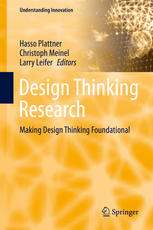
Product details:
ISBN 10: 3319196405
ISBN 13: 978-3319196404
Author: Hasso Plattner, Christoph Meinel, Larry Leifer
Design Thinking Research Making Design Thinking Foundational 1st Table of contents:
Introduction: The HPI-Stanford Design Thinking Research Program
1. Program Vision and Priorities
2. Road Map Through This Book
- 2.1 Part I: Tools and Techniques for Improved Team Interaction
- 2.2 Part II: Creativity and Creative Confidence
- 2.3 Part III: Measuring Design Thinking
- 2.4 Part IV: Documentation and Information Transfer in Design Thinking Processes
3. Summary
Part I: Tools and Techniques for Improved Team Interaction
Globalized Design Thinking: Bridging the Gap Between Analog and Digital for Browser-Based Remote Collaboration
- 1. Introduction
- 2. Overview of the Tele-Board System
- 3. Broaden System’s Availability: Transferring Tele-Board to the Browser
- 3.1 Web Browser Implementation Background
- 3.2 Tele-Board in the Web Browser
- 4. Easing System’s Application: Bridging the Gap Between Analog and Digital Worlds Through Whiteboard
- 4.1 Process and System Landscape Overview
- 4.2 Real Life Application Walkthrough
- 5. Conclusion
- References
Diagnostics for Design Thinking Teams
- 1. Introduction
- 2. Research Questions
- 3. Method
- 4. Interaction Dynamics Notation: An Overview
- 5. Development of the IDN Tool
- 5.1 Functional Requirements
- 5.2 User Interface Requirements
- 6. IDN Tool Specifications
- 6.1 Functional Specifications
- 6.2 User Interface Specifications
- 7. Analyzing Design Team Interactions with IDN Tool
- 7.1 Concept Generation Study
- 7.2 Expert Assessment
- 8. Detecting Interaction Patterns Correlated with Design Outcomes
- 9. Limitations
- 10. Discussion
- 11. Conclusion
- References
Design Thinking Health: Telepresence for Remote Teams with Mobile Augmented Reality
- 1. Introduction
- 1.1 Remote Patient Monitoring
- 1.2 Automating Knowledge-Based Procedures
- 1.3 Facilitating the Delivery of an Intervention
- 2. Clinical Needs Finding
- 3. The Need for an AR System in Wound Care
- 3.1 A Head-Mounted Display for Hospital-Acquired Pressure Ulcers
- 3.2 Existing Mobile Devices for Wound Photography
- 4. The Need for Improved AR Systems in Surgery
- 5. Current System Development
- 5.1 Google Glass Sensors
- 6. Conclusion
- References
Talkabout: Making Distance Matter with Small Groups in Massive Classes
- 1. Introduction
- 2. Related Work
- 3. Coordinating Global Small-Group Discussion
- 4. Assignment by Arrival Yields Diverse Groups
- 5. Structuring Talkabout Discussions
- 5.1 Create Opportunities for Self-Reference
- 5.2 Highlight Viewpoint Differences Using Boundary Objects
- 5.3 Leverage Students as Elaborators and Mediators
- 6. The Anatomy of a Talkabout Discussion
- 6.1 Discussions Follow a Distinct Conversational Pattern
- 6.2 Speakers and Spectators
- 7. Study 1: Do Discussions Improve Performance?
- 7.1 Method: Wait-List Control
- 7.2 Hypotheses and Measures
- 7.3 Participants
- 7.4 Results: Discussion Increases Class Participation, Marginally Improves Grades
- 8. Study 2: Does Diversity Improve Discussion Benefits?
- 8.1 Participants and Setup
- 8.2 Measures
- 8.3 Hypothesis
- 8.4 Manipulation Check
- 8.5 Results: Students in Diverse Groups Perform Better
- 9. Study 3: Large-Scale Field Experiment
- 9.1 Participants
- 9.2 Method
- 9.3 Hypotheses and Measures
- 9.3.1 Analysis Procedure
- 9.4 Results
- 9.4.1 High-Diversity Discussions Improve Scores
- 9.4.2 Benefits of Diverse Discussions Last Roughly 2 Weeks
- 9.4.3 Geographic Diversity Leads to New Perspectives
- 9.4.4 Gender Representation Does Not Influence Scores
- 9.4.5 Other Non-significant Factors
- 9.4.6 Other Measures of Geographic Diversity
- 10. Discussion
- 10.1 Comparing In-Person and Online Discussions
- 10.2 The Design Space of Online Peer Conversations
- 10.2.1 Always-Available Discussions Lack Critical Mass
- 10.2.2 Students Prefer to Negotiate Roles Informally
- 10.2.3 Rigidly Enforced Scripts Lower Satisfaction
- 10.2.4 Same-Partner Discussions Have Inadequate Participation
- 11. Conclusion
- References
Improving Design Thinking Through Collaborative Improvisation
- 1. Introduction
- 2. Approach and Background
- 3. Case Studies in Design
- 3.1 Mechanical Ottoman
- 3.1.1 Introduction
- 3.1.2 Prototype Systems
- 3.1.3 Designed Behaviors
- 3.1.4 Improvisation Sessions
- 3.1.4.1 Phase 1: Developing Behaviors
- 3.1.4.2 Phase 2: Exploring and Interpreting
- 3.1.4.3 Approaching
- 3.1.4.4 Taking Leave
- 3.2 Emotive Drawers
- 3.2.1 Introduction
- 3.2.2 Prototype Systems
- 3.2.3 Designed Behaviors
- 3.2.4 Improvisation Sessions
- 3.2.4.1 Proactive Action
- 3.2.4.2 Expressive Movement
- 3.3 Roving Trash Barrel
- 3.3.1 Introduction
- 3.3.2 Prototype Systems
- 3.3.3 Designed Behaviors
- 3.3.4 Improvisation Sessions
- 3.3.4.1 Interrupting Activity
- 3.3.4.2 Overt Non-interaction
- 3.3.4.3 Ascribing Desires
- 3.3.4.4 Empathy and Altruism
- 3.1 Mechanical Ottoman
- 4. Next Steps
- References
Part II: Creativity and Creative Confidence
Designing a Creativity Assessment Tool for the Twenty-First Century: Preliminary Results and Insight
- 1. Introduction
- 2. Assessing Creative Capacity
- 2.1 Creativity in the Twenty-First Century Defined
- 2.2 Convergent Thinking Tests
- 2.3 Divergent Thinking Tests
- 2.4 Artistic Assessments
- 2.5 Self-Assessments
- 3. Designing a Design Thinking Based Creativity Assessment
- 3.1 Case-Based Assessment
- 3.2 DTCT Components
- 4. Administration and Data Collection
- 4.1 Assessment Timing
- 4.2 Assessment Conditions
- 5. Data Analysis
- 5.1 Convergent Validity
- 5.2 Test-Retest Reliability
- 5.3 Discriminative Validity Analysis
- 6. Establish a Scoring Guide and Norms
- 7. Looking Ahead
- 7.1 Wider DTCT Administration and Further Refinement
- References
Innovation in Creative Environments: Understanding and Measuring the Influence of Spatial Effects on Creativity
- 1. Creative Environments as Enabler of Innovation Processes
- 2. Understanding the Influence of Creative Environments: Cultural Probes as Research Method
- 3. Designing a Cultural Probes-Set
- 4. Measuring the Perception of Spatial Effects
- 4.1 Space as a Medium and Mediator of Innovation Team Performance and Team Wellbeing
- 4.2 Different Working Modes of Innovation Teams Transported Through Spatial Environments
- 4.3 Designing Ideal Creative Environments for Individuals and Teams
- 5. Discussion of Findings and Further Research Questions
- References
Building Blocks of the Maker Movement: Modularity Enhances Creative Confidence During Prototyping
- 1. Introduction: Modules for Makers
- 1.1 Modularity and the Black Box
- 2. Background
- 2.1 The Modularity Tradeoff: An LED Example
- 2.2 Prototyping Metrics
- 2.2.1 Bandura´s Self-efficacy and the Confidence to Create
- 2.2.2 Cognitive Flow and Modularity
- 3. Related Work
- 3.1 Conformity in Creative Generation Design Tasks
- 3.2 Timing Effects on Creative Output: A Crowd-Sourced Design Task
- 4. Methods
- 4.1 Participants and Groups
- 4.2 Procedure
- 5. Results
- 6. Discussion
- 6.1 Translating to Physical Toolkits
- 7. Conclusion
- References
Part III: Measuring Design Thinking
Measuring the Impact of Design Thinking
- 1. Introduction
- 2. Survey and Interview Sample
- 3. Insights
- 3.1 Insight #1: Mind the Definition
- 3.2 Insight #2: Impact? Yes! Measure It? No
- 3.3 Insight #3: Not All Consider Their Measurements to Be Valid
- 3.4 Insight #4: Design Thinking Is Measured in Manifold Ways
- 3.5 Insight #5: The Impact of Design Thinking as a Butterfly Effect
- 3.6 Insight #6: Story-Based Approaches: A Silver Lining
- 4. Conclusion
- 5. Limitations of the Study and Future Research
- References
Developing Design Thinking Metrics as a Driver of Creative Innovation
- 1. Introduction
- 2. Study 1: Creative Agency
- 2.1 Background
- 2.2 Materials
- 2.3 Procedure
- 2.4 Discussion
- 3. Study 2: Design Thinking Measures in Organizations
- 3.1 Background
- 3.2 Procedure
- 3.3 Results
- 3.3.1 Empathy Measures
- 3.3.2 Reframing
- 3.3.3 Iteration
- 3.3.4 Team Collaboration
- 3.4 Discussion
- References
Part IV: Documentation and Information Transfer in Design Thinking Processes
Experience and Knowledge Transfer Through Special Topic Coaching Sessions
- 1. Introduction
- 2. Related Work
- 3. The Concept of Special Topic Coaches
- 4. Coaching Seminar for ME310
- 5. Evaluation
- 5.1 Self-Evaluation of the Coaches
- 5.1.1 General Impressions
- 5.1.2 Tools
- 5.1.3 Theory vs. Practice
- 5.1.4 Summary
- 5.2 Evaluation of Coaches by Student Teams
- 5.2.1 General Impressions
- 5.2.2 Tools
- 5.2.3 Theory vs. Practice
- 5.2.4 Summary
- 5.3 Coach and Student Ratings
- 5.3.1 General Ratings
- 5.3.2 Rating of Theory and Practice
- 5.3.3 Rating of Suitability to Process
- 5.4 Evaluation of Coaches by the Advisors
- 5.1 Self-Evaluation of the Coaches
- 6. Outlook and Summary
- References
Smart Documentation with Tele-Board MED
- 1. Design Thinkers and Behaviour Psychotherapists: A Promising Collaboration
- 1.1 Documentation Needs and Solutions in Design Thinking
- 1.2 Documentation Needs and Solutions in Behaviour Psychotherapy
- 1.3 Suggesting a Design Thinking Based Documentation Solution for Behaviour Psychotherapy
- 2. Designing a New Documentation Tool: The Automatic Tele-Board MED Session Protocol
- 2.1 Exploring the Status Quo of Protocols in Behaviour Psychotherapy
- 2.2 Devising and Refining a New Documentation Concept: The Short Visual Protocol
- 2.3 Realizing an Automatic Protocol Function
- 2.4 Building on a “Sandwich Metaphor”: Suggestions for Using the Automatic Protocol
- 2.5 Testing the Automatic Tele-Board MED Protocol Function
- 3. Tele-Board MED Supports Documentation in Diverse Behaviour Psychotherapeutic Settings
- 3.1 Collecting Information for Case Reports
- 3.2 Using Analysis Schemes
- 3.3 Supporting Exercises
- 3.4 Supporting Psycho-Education
- 3.5 Sessions with a Lot of Interaction Apart from Tele-Board MED
- 4. Contributions to Design Thinking Documentation
- References
Preserving Access to Previous System States in the Lively Kernel
- 1. Introduction
- 2. Background
- 2.1 Prototype-Based Programming
- 2.2 The Lively Kernel
- 2.2.1 Programming with Prototypes and Classes
- 2.2.2 Direct Manipulation of Morphs
- 2.2.3 Saving Morphs to the Shared Parts Bin Repository
- 3. CoExist
- 4. Motivation
- 4.1 Part Development by Example
- 4.2 Recovery Needs When Developing Parts
- 5. Object Versioning
- 5.1 Version-Aware References
- 5.1.1 Versions of Objects
- 5.1.2 Version-Aware References
- 5.1.3 Versions of the System
- 5.1 Version-Aware References
- 6. Discussion
- 6.1 Using Proxies as Version-Aware References
- 7. Summary
- References
Connecting Designing and Engineering Activities III
- 1. Introduction
- 2. Recovery Approach
- 3. Design Thinking Documentation Recovery
- 3.1 Design Thinking Ontology
- 3.2 Recovery Model
- 3.3 Recovery Modules
- 4. Evaluation
- 4.1 Qualitative Evaluation
- 4.2 Quantitative Evaluation
- 4.3 Threats to Validity
- 5. Related Work
- 6. Conclusion and Future Work
People also search for Design Thinking Research Making Design Thinking Foundational 1st:
the main objective design thinking research is
hpi stanford design thinking research program
design thinking research achieving real innovation
research design why thinking about design matters
primary and secondary research in design thinking
Tags:
Hasso Plattner,Christoph Meinel,Larry Leifer,Design,Thinking Research,Making Design,Thinking,Foundational 1st
You may also like…
Education Studies & Teaching - Educational Theory
Design Thinking for Digital Well being Theory and Practice for Educators 1st Edition Chambers
Business & Economics - Others
Design Thinking For Dummies 1st Edition Christian Muller-Roterberg
Computers - Web Development
Arts - Architecture
Uncategorized
Computers - Applications & Software



